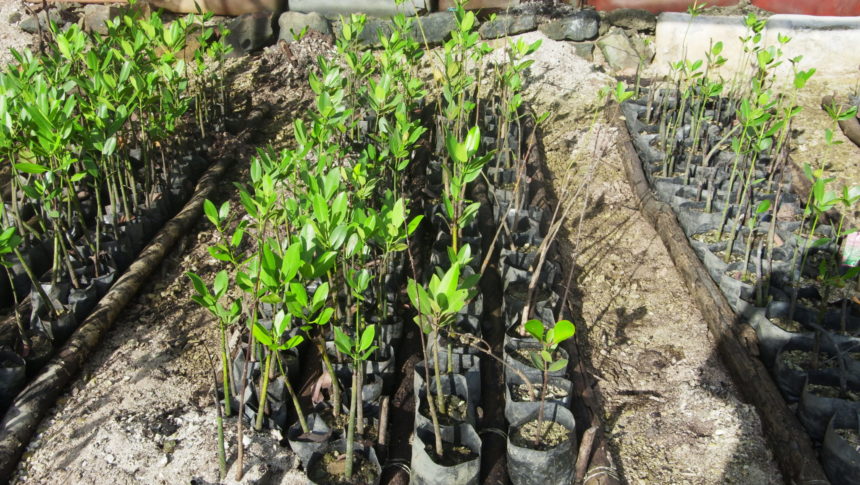Mangrove is a supertree that offers a lot of benefits for the environment and coastal communities. They thrive in the Anambas coastlines where three mangrove species are dominating the area: Rhizopora apiculata, Buguiera gymnorrhiza and Corops tagal.
They are great for carbon absorption and offer huge economic values for local communities because they provide habitat for fish, also their fruits can be used to make jam, syrup and chips.[1]
Here we show you the many ways mangroves can be used as food sources:
Flour
There are two types of mangroves whose fruits can be turned into flour: Avicennia sp and Bruguiera gymnorrhiza, however, they are processed differently. The first species, Avicennia sp, follows a two-step process: first, the fruit has to be cooked several times to remove the sap and bitter taste, and then they are milled into flour. The Avicennia sp flour is best used as an ingredient to make cakes, onde-onde (flour balls), cendol (silky green jelly) and chips.[2]
As for the Bruguiera gymnorrhiza species, according to research, their fruit contains 371 calories/100gr of energy, 85.1gr/100gr of carbohydrates, 73.756% of water content, 1.246% of fat content and 23.52% of protein content.[3] The flour made from this species can be used as a baking ingredient for all types of cakes.[4] To turn them into flour, first the fruit has to be peeled, then chopped into tiny pieces. Next is to boil them for 20-30 minutes, don’t forget to stir regularly when they reach boiling point. After that, rinse and dry them in the sun for about one day. The fruit that has been dried in the sun will shrink so they have to be soaked in water before putting them in a blender. Once they turn into a pulp they have to be sun-dried and ground again for the second time before finally sifting them.
Crackers
Making mangrove crackers from Rhizopora mucronata species fruit follows similar steps to making mangrove flour. The fruit has to be soaked in water for two days to remove the sap and bitter taste, turn it into a pulp with a blender, sun-dry and ground into powder. The mangrove flour then is mixed with tapioca and seasonings, steamed and then sliced thinly and dried in the sun before deep-frying it.[5]
Syrup
Mangrove syrup is a quick homemade syrup that’s perfect for flavoring your drinks. The persimmon-like fruit of sonneratia sp. species, also known as mangrove apple, is often used to make this mangrove syrup. The process is very simple, the fruit is peeled, rinsed and ground. Then, mix one part mangrove with two parts of water and two parts of sugar, and cook. The final steps are to strain the mixture and let it cool.[6]
Dodol
Dodol is a traditional Indonesian sweet made from glutinous rice, palm sugar and coconut milk. There are many different dodol recipes and varieties found in Indonesia, one of them is mangrove dodol. In Teluk Betung Village in South Sumatra, the villagers there make dodol using nipa palm (Nypa fruticans) fruit. The fruit is first cleaned, then cut into small pieces, blend until smooth and strained to remove any solids left. The Next step is to mix it with coconut milk, glutinous rice flour and palm sugar, cook for two hours or until the mixture thickens, stir regularly. Once it has reached the desired consistency, turn off the heat and let it cool before serving.[7]
Sources:
[1] Ilman, M., Iwan T.C.W., and I N. N. Suryadiputra. 2011. State of the Art Information on Mangrove Ecosystems in Indonesia. Wetlands International – Indonesia Programme. Bogor.
[2] Satoto, H.F., sudaryanto, A. 2020 pengolahan buah mangrove menjadi sirup mangrove di kawasan wisata hutan mangrove Surabaya. Journal of community service consortium.
[3] Rokh Eddy Prabowo 2015 Peluang Bisnis Kuliner Buah Mangrove. Prosiding seminar nasional.
[4] Satoto, H.F., sudaryanto, A. 2020 pengolahan buah mangrove menjadi sirup mangrove di kawasan wisata hutan mangrove Surabaya. Journal of community service consortium.
[5] Sulistiyanti, T.D., and Puspitasari, Y.E. 2015. Kerupuk mangrove antidiare dari buah mangrove Rhizopora Mucronata. Jounal of innovation and applied technology
[6] Satoto, H.F., sudaryanto, A. 2020 pengolahan buah mangrove menjadi sirup mangrove di kawasan wisata hutan mangrove Surabaya. Journal of community service consortium.
[7] Mukti,R.C., Arsi, Pangawikan,A.D. 2020. PKM pemanfaatan bauh nipah di desa teluk betung, kecamatan pulau rimau, sumatera selatan. Jurnal Qardhul hasan

